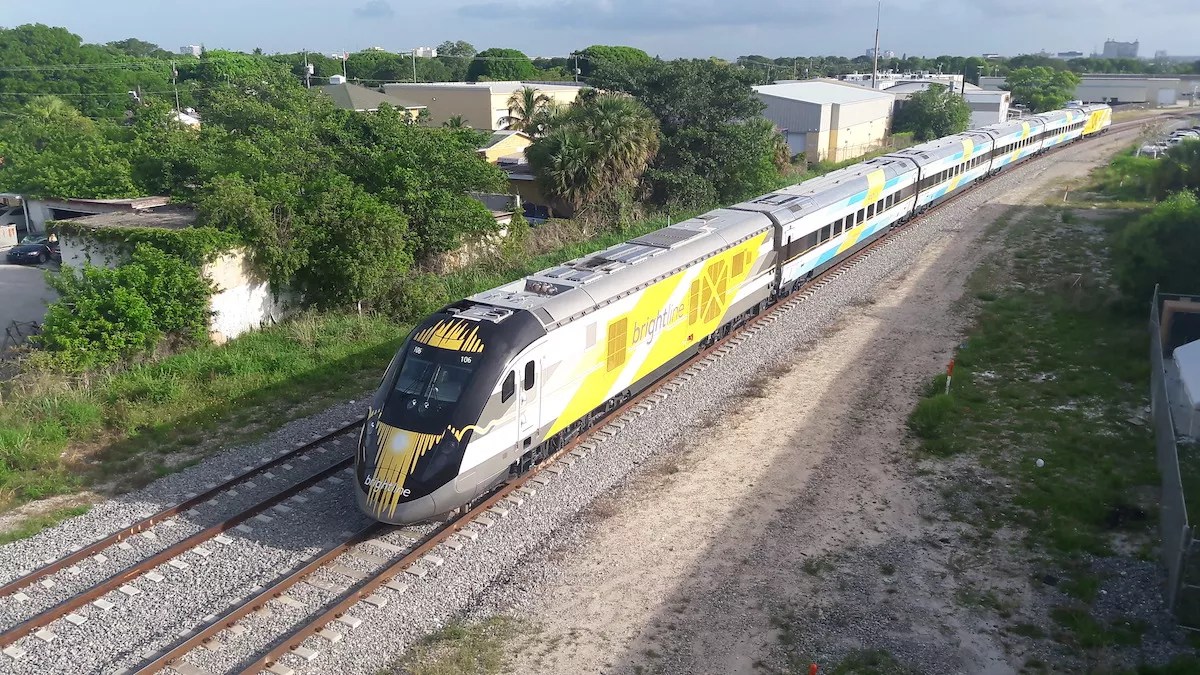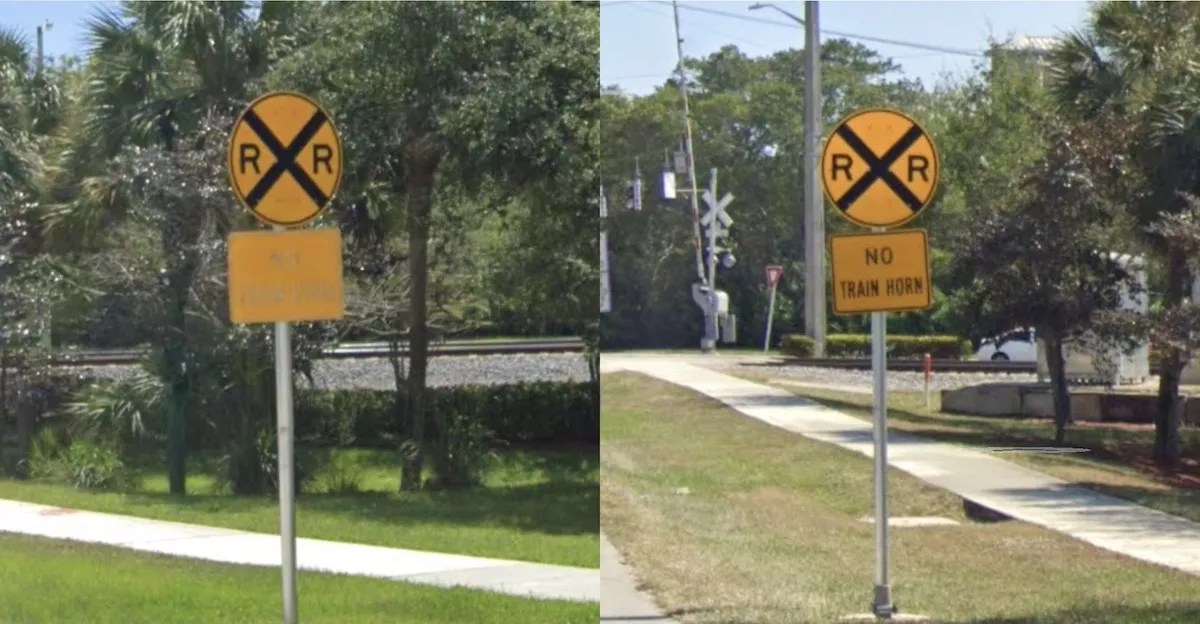
Flickr via BBT609

Audio By Carbonatix
On the afternoon of October 25, 2022, James “Jim” Ostrowski was on his way to meet his wife at their local gym in Boca Raton. While the 74-year-old and his wife usually drove to the fitness center together, he decided to walk instead. He was ready to leave before she was and wanted some extra exercise.
But as outlined in a recent lawsuit Carol Ostrowski filed against the high-speed rail company Brightline, her husband never made it to the gym.
He’d nearly made it across the railroad tracks near the intersection of SW 18th Street and South Dixie Highway – notably a “quiet zone,” a designated section of a rail line where trains aren’t required to sound their horn when approaching crossings – when he was struck and killed by a Brightline train, according to a police report about the accident and the lawsuit (both of which are attached to the bottom of this story).
The lawsuit claims that although “quiet zones” are typically marked by signs warning pedestrians about the lack of audible warning, the lettering on a “No Train Horn” sign situated near the Boca Raton tracks was “faded and essentially invisible” at the time of Ostrowski’s death – allegedly in violation of federal law.
This year, make your gift count –
Invest in local news that matters.
Our work is funded by readers like you who make voluntary gifts because they value our work and want to see it continue. Make a contribution today to help us reach our $30,000 goal!
“There was no way of reading this sign,” attorney Todd Baker at Kogan & DiSalvo in Boynton Beach, who is representing the Ostrowski family, tells New Times.
The lawsuit, which seeks a jury trial and judgment for damages, claims Brightline’s insufficient signage led to Ostrowski’s untimely death.
“[James’ family members] want justice for what happened to him. They want Brightline to accept responsibility and be held accountable for what they did to Jim,” Baker says. “But they also want [Brightline] to make real changes so that it doesn’t happen again.”
“This isn’t suicide, this isn’t drug addiction, this isn’t mental health,” Baker tells New Times, alluding to the fact that a number of deaths involving Brightline trains have been classified as suicides. “This is a dangerous company operating in a dangerous space, and innocent people are dying as a result.”
Baker says the lettering on the “No Train Horn” sign near the Boca Raton crossing is now legible, but it’s unclear when it was changed.
That said, Google’s Street View feature allows users to compare archived photos against the default display of its most recent image. The most recent Google image of the intersection where Ostrowski was killed is timestamped February 2023, several months after the accident. The image prior to that was captured in April 2022, six months prior to the fatal day.
At the time of publication, a spokesperson for Brightline had not responded to New Times‘ request for comment.

Unretouched Google Street View images of the “No Train Horn” sign at the Boca Raton railroad crossing from April 2022 (left) and February 2023 (right)
Screenshots via Google Street View
Deadliest Train per Mile
The suit emphasizes that Ostrowski’s death was preceded by “countless other deaths along the railway corridor during the operation of the Brightline train, some of which occurred under similar circumstances, where warning signs were either inadequate or improperly maintained.”
Singled out as the deadliest train per mile in America by the Associated Press, Brightline has logged dozens of fatalities across South Florida in the years since its 2017 debut. New Times has catalogued more than 50 pedestrian and motorist deaths caused by collisions with the company’s trains since January 2022. Most of those fatal incidents involved pedestrians, some of whom police say committed suicide.
In August 2022, Brightline announced a $45 million federally funded project entailing the construction of “at least 33 miles of pedestrian protection features and supplemental safety measures.” The company said it would upgrade its railway with fencing, better safety signage, and raised pavement markers, among other upgrades stretching from Brevard to Miami-Dade counties.
The train, which can achieve speeds of up to 125 mph at times, is limited to 79 mph through densely populated urban and suburban areas.
It remains unclear how fast the train was moving at the time of Ostrowski’s death.
Eyewitness Accounts
Carol Ostrowski’s lawsuit claims that a “lack of any train horn” played a role in James Ostrowski’s death. But witness accounts cited in a police report obtained by New Times appear to contradict this.
According to an investigative report by the Boca Raton Police Department, the train’s driver told police that he saw Ostrowski looking down as he jogged across the railroad tracks and attempted to get his attention by blowing the horn “multiple times.”
“[The driver] started to blow the horn, and the male never looked or and/or acknowledged the train,” the report states. “The male continued to slowly jog right in front of the train, so [the driver] placed the train in emergency mode, and then the train struck the male.”
Several witnesses, including the train’s conductor, confirmed the engineer’s account, telling police they saw Ostrowski running across the tracks with his head down when he was hit by the Brightline train.
“The male was looking straight ahead and never deviated from his jog,” the conductor told police.
Ostrowski’s family emphasized to police that Ostrowski was “not suicidal” and had no mental health issues, hearing or eyesight impairments “besides those common with typical aging,” according to the report.
The Ostrowski family’s attorney, Todd Baker, did not respond to follow-up questions from New Times regarding the witness accounts included in the police report.
Retired Sara Lee/Hanes CEO
Born in Rhode Island, James Ostrowski was retired and living in Boca Raton with Carol Ostrowski, his wife of more than 52 years at the time of his death, according to an online obituary. He was an avid golfer and sports enthusiast.
He worked at the Sara Lee Corporation for most of his career, including as president and CEO of Sara Lee/Hanes Underwear, and also served as an advisor for Florida Atlantic University’s (FAU) College of Education Executive Leadership Study.
“Right up to the last day of his life, he was always there to provide advice and support to his family and friends. He loved to play golf and talk about the meaning of life with his grandson, Zach, and to root for the New England Patriots with his other grandson, Jimmy,” the obituary reads.
“He was looking forward to living out the rest of his years with his loving wife, being there for his family and friends,” Baker adds. “He earned the right to enjoy his golden years through hard work, through community involvement. And it was all taken.”